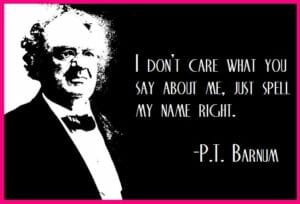 How do you make sure a donor will actually read your appeal letter? You must get their name right.
How do you make sure a donor will actually read your appeal letter? You must get their name right.
After the envelope and the postscript–sometimes, even before the P.S.–the first thing the donor looks at is their name in the salutation. If the letter is sent to “Dear Friend,” that increases the chances that the donor will throw it away unread.
And if you get the name wrong, you may never get a gift from them again!
Over a lifetime, that could be hundreds or thousands of dollars that donor wanted to give your nonprofit–but ended up giving to some other organization. One that said I know you with the very first words of the appeal letter.
Why “Dear Friend” Loses Donors
Maybe the Southern Law Policy Center can get away with “Dear Friend.” They have a huge mailing list and an established brand.
Maybe the Arthritis Foundation can do it. They have a built-in constituency of people with arthritis pain.
But most organizations are not like those big national concerns. Some are national but very focused on one issue, like About Face: Veterans Against the War. Some are regional, like the Appalachian Community Fund. And many, many of us work at community-based organizations, focused on one city or town.
People who give to your smaller nonprofit identify with your work. They give because it’s their way of making a difference. In return, they expect you to know them and what they care about.
This chance to build a relationship with your donors is the superpower of the smaller nonprofit! But if your small nonprofit goes with “Dear Friend,” you are giving away your biggest advantage in fundraising: your ability to add a personal touch. Make the size of your list work for you.
How Do You Know What to Call the Donor?
 You might have chosen “Dear Friend” in the past because there are so many ways of calling the donor by the wrong name.
You might have chosen “Dear Friend” in the past because there are so many ways of calling the donor by the wrong name.
True, you don’t want to:
- Mail to Dennis Fischman when you should be asking Rona and Dennis Fischman.
- Call someone “Mary” when she only answers to “Mrs. Kimble.”
- Call someone “Mrs. Kimble” when that person goes by Ms., or Mx., or Mary.
- Mail to Chang Sho Huang and say “Dear Chang,” only to find out you’ve just called them by their family’s name (like writing to me, “Dear Fischman”!)
The solution to this in the short term might be to use the full name: “Dear Dennis and Rona Fischman.” As soon as you can, however, the best solution is to ask.
You could ask online donors immediately, on the post-donation page of your website that thanks them for their donations.
You could also ask them when you call them to thank them for their donations. Or in a donor survey.
The key is to ask–to record the answers–and then, to call them by the name they prefer.
How Do You Remember the Right Name?
Let’s face it, most of us are bad at remembering names.
On the personal level, there’s a theory that human beings are only capable of knowing 150 people and remembering how I know you and vice versa. On the organizational level, that’s the same number that’s recommended as the maximum a major gifts officer should have on their caseload.
Even if your Development Director has an exceptional memory for names, faces, and life stories, your organization will someday have the fortunate problem of getting too big for any one person to keep the data in their head.
That’s why you need a database.
Warning: Excel is not a database!
Both my wife and I have received email from organizations we like and support that called us by the wrong name. In both cases, the “first name” data from one line of an Excel spreadsheet had been combined with the email address from another line.
There are many reasons why your nonprofit needs an actual database or constituency relationship management (CRM) system, but getting the names right is one of the most important.
If any of this sounds confusing, or if it sounds like too much work to do on your own, email me at [email protected] to set up a time to talk about whether you could use some consultant help. Because whatever else you do for donors, you must get the name right.



